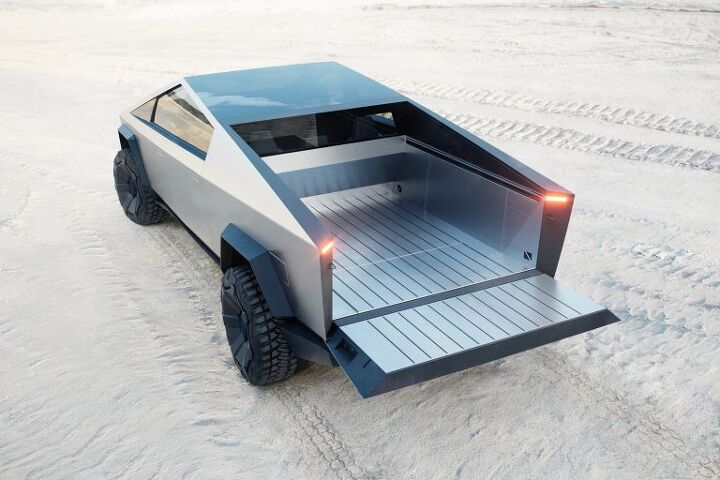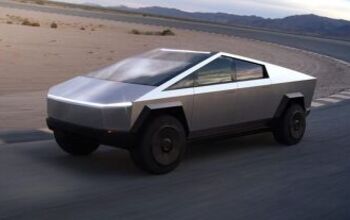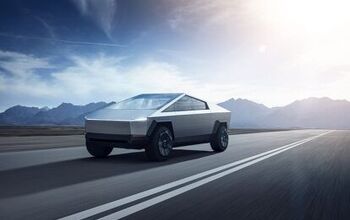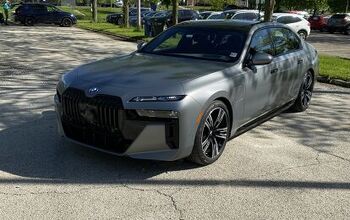Tesla Cybertruck Delayed Until At Least 2023

During last week’s earnings call, Tesla CEO Elon Musk confirmed that the Cybertruck would be delayed until at least 2023. That places the polygonal pickup two years behind its original schedule. But who among us with knowledge of the automaker’s production history actually thought it would be delivered on time?
Delaying products has become a hallmark of the Tesla brand and Musk doesn’t seem to be sweating it. Rather than focusing on launching a new vehicle for 2022, the business wants to prioritize increasing capacity and finalizing its move from California to Texas. Now based in Austin, Tesla made $5.5 billion last year compared with the previous record year of $3.47 billion in net income posted in 2020. Musk said the shift into routine profitability is proof that EVs are viable, adding that the company could have done even better if factory output hadn’t been so constrained last year. Unfortunately, those hurdles haven’t dissipated for 2022, encouraging the automaker to wait on both the Tesla Cybertruck and Roadster.
While the company has had its sights focused on improving production capacity by setting up new facilities around the world, Musk expressed concerns about the global chip shortage. He remained confident that volume would come up by 50 percent in 2022 (vs 2021). But feared that supply constraints could make any new models more trouble than they’re worth.
Due to the popularity of the semiconductor chip excuse, I’ve come to the conclusion that its become the default explanation for domestic manufacturers walking back targets or failing to reach stated goals. While you occasionally hear foreign automakers cite shipping obstacles relating to the varied pandemic restrictions between nations and unique component shortages — usually in tandem with the worldwide deficit of semiconductors — American brands rarely bring up anything other than the missing chips whenever a factory needs to be idled.
But Tesla doesn’t need an excuse. The brand has been around long enough for us to know what it’s about and product delays are par for the course. Unfortunately, that also means there’s a good chance Tesla’s upcoming pickup won’t be how exactly you remembered it. Back in 2019, Tesla estimated that the production of the dual-motor and tri-motor Cybertruck (both all-wheel drive) would begin in late 2021. A rear-drive variant was supposed to follow roughly a year later with an MSRP just shy of $40,000.
Delays already seemed assured, though the company failed to confirm anything until August of 2021. Postponements have come to be expected in the subsequent months. Meanwhile, the industry having failed to produce cars anywhere near a normal pace over the last two years has sent pricing into the stratosphere — making that sub $40,000 starting point feel like wishful thinking.
The truck itself has also been changing. Many people had questions about whether or not Cybertruck would receive regulatory approval in its conceptual format in 2019, noting the absence of wipers and door handles. Tesla has since added both, with the pickup also receiving traditional folding mirrors and a few other tweaks. Musk has previously said that the general design will remain consistent with the concept. But we know that the automaker has shrunk the vehicle’s size slightly (3 percent, according to Elon) and given it a flatter-looking roofline. The beltline also appears to have been lowered.
Tesla’s CEO also poured water cold water over any suggestions the business was on the cusp of launching a $25,000 battery electric vehicle to be slotted below the Model 3. Musk has been referencing the prospective vehicle sporadically since 2018, saying all it needs is for battery production costs to come down. But it appears to be little more than a quick way of pumping up investors and keeping the hopes of the underpaid alive. In 2020, the executive again suggested that a $25,000 all-electric hatchback could arrive within three years. But he confirmed no such vehicle was in development during last week’s earnings call.
“We are not currently working on a $25,000 car,” Musk said. “At some point we will. We have enough on our plate right now.”
Considering the current focus on maximizing volume, a budget alternative to the Model 3 sounds like a useful addition to Tesla’s lineup. But it’s hard to imagine Tesla coming out with an EV priced below $30,000 that’s of much practical value to the brand. Most budget-conscious electrics retail closer to $35,000 and those starting lower occasionally have ranges that fail to exceed 200 miles between charging. While that doesn’t make them useless, it does limit the number of customers that will be interested. Tesla, which has taken pride in offering luxury products with above-average range estimates, could lose some cachet if it dumps something cheap onto the market to be outclassed by the $30,750 Mini Mini Cooper SE and its 110 miles of range.
[Image: Tesla]

A staunch consumer advocate tracking industry trends and regulation. Before joining TTAC, Matt spent a decade working for marketing and research firms based in NYC. Clients included several of the world’s largest automakers, global tire brands, and aftermarket part suppliers. Dissatisfied with the corporate world and resentful of having to wear suits everyday, he pivoted to writing about cars. Since then, that man has become an ardent supporter of the right-to-repair movement, been interviewed on the auto industry by national radio broadcasts, driven more rental cars than anyone ever should, participated in amateur rallying events, and received the requisite minimum training as sanctioned by the SCCA. Handy with a wrench, Matt grew up surrounded by Detroit auto workers and managed to get a pizza delivery job before he was legally eligible. He later found himself driving box trucks through Manhattan, guaranteeing future sympathy for actual truckers. He continues to conduct research pertaining to the automotive sector as an independent contractor and has since moved back to his native Michigan, closer to where the cars are born. A contrarian, Matt claims to prefer understeer — stating that front and all-wheel drive vehicles cater best to his driving style.
More by Matt Posky
Latest Car Reviews
Read moreLatest Product Reviews
Read moreRecent Comments
- Bd2 Ultimately, it comes down to price/whether it makes financial sense for buyers (right now, BEVs just aren't there, even with the tax credit). HEVs are finally seeing their place in the sun, decades after being a niche market; this is due to premium for HEVs having narrowed significantly with pure ICE, whereby buyers can recoup that after 2-3 years of ownership.
- MaintenanceCosts I've experienced three cars that were the first year of the model. The two I bought (first-off-the-boat 2004 TSX and midyear 2006 Civic) were both Hondas and were both flawless. The other one was my ex-stepmother's 1990 Land Rover Discovery. It was one of the very first Euro-spec models, a two-door with an asthmatic carbureted 3.5L V8 and a five-speed manual. Every part of the car broke at some point, including things like hatch hinges that really shouldn't break. It turned her off Land Rover forever, and her cars since have all been Subarus.
- MaintenanceCosts When I was living with my Bolt in a rental condo and charging from 120V in the garage, as soon as the association figured out what was happening, they asked me to pay $30 a month to cover the cost. That's pretty close to what I was using so I had no issue with it.
- SCE to AUX I've had mixed results with first-year cars:71 Pinto - good. 85 LeBron GTS - good. 96 Grand Voyager - good. 02 Passat B5.5 - bad. 05 Odyssey - bad. I also had a last-year car that was terrible (80 Bobcat), but most cars were crap then, anyway.
- Crown Go big or go home. Never understood the "economy version" that manufacturers make of a performance car.


































Comments
Join the conversation
With it's debut pushed back once more I'm a little surprised some enterprising custom shop hasn't built a buck to create fiberglass replica Cybertrucks to sit on a regular truck chassis.
very interesting: Majority of Canadians Now Want COVID Rules to End After Trucker Revolt Massive 15 point swing in sentiment suggests trucker are not “fringe minority.”